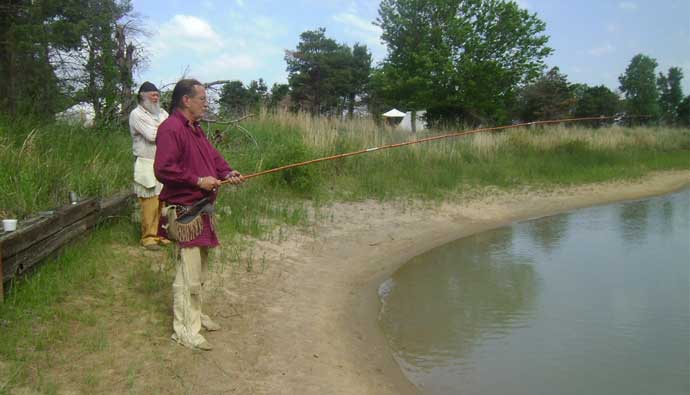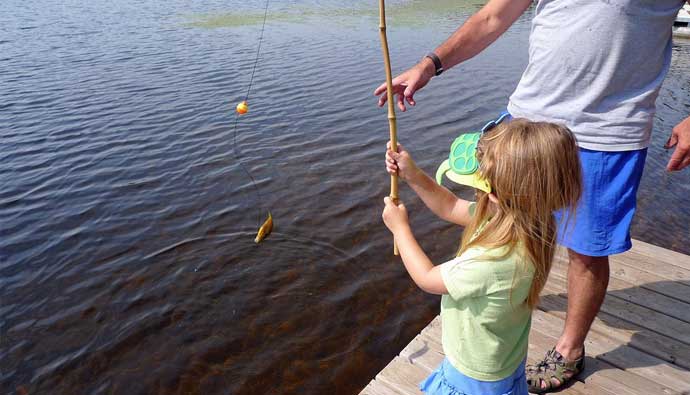How to Fish With a Bamboo Pole Updated
How to Fish With a Bamboo Pole
How to Setup a Cane Pole | Fishing 101
Cane pole angling is a tried and truthful method of fishing that endless generations have partaken in.
Whether you want to go after largemouth bass, crappie, or big grouper in the bounding main, there's a pikestaff fishing pole that will handle the job.

In this article, we'll comprehend the different types of cane pole styles, how to rig them, and how to fish with a cane pole.
Get your poles fix and permit's dive in!
What is a Cane Pole?
A pikestaff fishing pole is a large stick, typically a bamboo pole, that has a angling line attached to the end of information technology. This line is typically the same length or a flake longer than the length of the pole and has a claw and bait at the terminate.
Cane poles are used for still-line-fishing and primarily for panfish species. When the angler hooks the fish they raise the pikestaff pole to bring the fish close to their torso and secure them using a internet.

There are videos of boat fishermen in the ocean using poles to hook fish and flip them into the boat, but these tend to be pole made of metal or fiberglass. You lot tin use this method with a cane pole if you're conscientious, just most anglers adopt the more graceful route of using a cyberspace.
Adjacent, let's dive into some of the various styles of pikestaff poles. Some are older and not as common and some have been developed recently due to newer manufacturing processes.
Our Favorite Pikestaff Pole
four Types of Cane Poles
Bamboo Cane Poles
Bamboo cane poles are made from stalks of bamboo that are cut and formed into the desired length pole.
Popular types of bamboo used for these poles are Dendrocalamus Strictus, Bambusa Tuida, and Bambusa Arundinacae.
To ensure durability y'all're looking for bamboo that is solid and strong with dense walls. You desire the nods to exist closer together for the added forcefulness likewise.
Bamboo cane poles come up in diverse lengths but the typical range is between four and twenty-five feet long.

Treated vs. Untreated Bamboo
Depending on the bamboo manufacturer you can get treated and non-treated poles. Treated bamboo removes many of the insects and fungi that could damage and degrade your pole.
The mutual treatments include leaching, smoking, borax, and boric acid mixture, and a CCB Treatment of copper, chrome, and boron). If you don't want fungi, termites, or weevil, and then we recommend you become for the treated bamboo.
Does Bamboo Interruption?
The short answer is that bamboo does break if you don't take care of it. Especially if you apply untreated bamboo, the insects and fungi will dethrone it and information technology'll intermission much faster than treated bamboo.
Fifty-fifty a treated pole will break if you exit it in h2o, slam it in your machine door, or let information technology warp in a hot machine. Bamboo is robust, but information technology's non indestructible.
More on How to Make Bamboo Cane Poles.
Jigger Poles
Jiggerpoling is an onetime-school method of fishing for largemouth bass and other fish past making quiet conscientious presentations of lures close to cover.
Near anglers utilise a floating minnow-shaped plug, part of a fish abdomen, or fifty-fifty some pork meat attached to a hook. This allurement is placed on a short leader line that's directly fastened to the tip of the jigger pole.
The angler unremarkably sits on a small boat and moves the lure or bait along the comprehend to elicit a bite. Presenting the bait almost grass or downed wood.
This method works well when the water isn't clear and the bass is located closer to the cover.

Calcutta Poles
Back in the day, Calcutta bamboo poles were the best fishing poles on the market. It'due south funny to think that a long stick and line would be constructive when everyone today is using the top of the line fiberglass and graphite technologies.
In that location's i human being back in 1956 named Ernie Giglio who caught a 49-pound striped bass which earned him second place at the Long Beach City Surf Fishing Competition.
All he used to bring in that monster fish was a Calcutta, a guide, and a elevation. Best of all he didn't use a reel seat, he just clamped the reel to the rod using hardware clamps.
Even funnier that together with what we'd consider a vintage cane rod, he had a Penn Squider with Dacron line since monofilament wasn't a thing in those days.
If you're looking to become back into how the one-time timers used to fish, it's worth picking upwardly some bamboo and making one of these one-time pikestaff line-fishing poles yourself!
Telescopic cane poles
TENKARA SETUP: How to Set Up Your Tenkara Rod FAST + Communicable Brown Trout About Yosemite
Not all cane poles are made from bamboo or wood. If you're looking for a mod pikestaff pole, you should bank check out the fiberglass pikestaff poles and graphite pikestaff poles on the market.
These are made from different bore tubes that have a taper. When you put them together they form a big pole that can then exist used for line-fishing.
This makes traveling with them easy since most are longer than 12 feet, which can brand it difficult to get in and out of your car. These telescoping fiberglass pikestaff poles, for example, are popular with backpackers who require a lightweight minor pole that can be used for Tenkara fishing in the backcountry.
How to Rig a Pikestaff Pole
Cane pole rigging is a little different than your standard setup. Since you're likely fishing with but a flexible bamboo pole, you lot're going to need to attach your line to the pole.
Don't tie your line direct from the tip!
Total Outdoorsman: How to Rig a Cane Pole
Wrapping Your Pikestaff Pole
Pikestaff poles tin break and y'all'll but leave a fish out there with a hook in its oral cavity pulling the tip of your pikestaff pole around until it dies.
Information technology'due south improve to take some dacron and commencement from the base of operations handle or halfway up your pikestaff pole and tie a knot there equally an anchor betoken. This manner if your tip breaks your line is notwithstanding fastened to a non-broken part of your pole.
Wrap your dacron around leaving about an inch or two of space between wraps. When yous get to the top then tie another knot or half hitch at the top to keep the line in place.
Bring your dacron downwardly from the tip to the base of your pole. Make a loop knot at the stop.
Leader and Tackle
Take some monofilament and necktie a loop knot at ane stop. Take this loop and your dacron loop and make a loop to loop connection.
Then put an Aberdeen claw on the other cease, some split shot weight and a bobber upwards top. Now you take a setup ready to catch fish!
Rigging a Telescopic Cane Pole
Since the fabric is tougher with fiberglass and graphite cane poles y'all can necktie off your line straight at the tip. If you're on the worrying side, then it doesn't injure to come down from the tip almost a human foot and tie your line to this stronger expanse.
So simply wrap upward to the tip and tie some other knot and proceed to create a leader with your favorite gear up up every bit nosotros mentioned in a higher place.
How to Fish With a Cane Pole
Cane pole line-fishing is one of the easier methods of fishing since you lot've taken out a lot of unnecessary headaches with the reel.
How to Use a Pikestaff Pole
Line-fishing with a cane pole is equally easy as placing your lure or bait where the fish might exist and giving the right presentation.
Since there is no real casting involved, either drib your line direct where your cane pole tip tin reach or if there is current, let the bait drift to where you want it to become downstream.
Catching a Fish
When you feel a scrap, gently pull upwards on your pole and set up the claw. Instead of reeling the fish in, you'll elevator the pole loftier into the air to bring the fish closer to yous. If the fish is light and then experience free to pull the fish out of the h2o and into your hand or on the ground.
Remember, it's better to keep the fish in the h2o if you programme to take hold of and release as it doesn't expose them to potential infection if you remove their slime coating.
If the fish is bigger than you'll want to bring the fish shut to you and utilise a net to secure it.
Cane Pole Angling Techniques
Fishing with a cane pole is fun and it tin be used to catch fish including:
- Bass
- Crappie
- Bluegill
- Trout
- Catfish
If you're looking for take hold of bass, be certain to use a lure that works well in cover. From there nowadays the lure that looks as natural to the bass equally possible and waits for the bite.
The squeamish part about a cane pole is that later y'all movement the lure past an surface area all you accept to do is pull up the pole and drop the lure correct dorsum at where you started.
For other fish like trout and bluegill, just change out the type of bait and place it in the proper area of the lake or river.
It'southward like shooting fish in a barrel to overthink this manner of fishing and then remember to keep it simple.
Good luck out at that place!
The Anglers Behind This Article:
How to Fish With a Bamboo Pole
Posted by: cornetthopearabits.blogspot.com

0 Response to "How to Fish With a Bamboo Pole Updated"
Post a Comment